engine AUDI S3 2009 Manual Online
[x] Cancel search | Manufacturer: AUDI, Model Year: 2009, Model line: S3, Model: AUDI S3 2009Pages: 324, PDF Size: 76.02 MB
Page 236 of 324
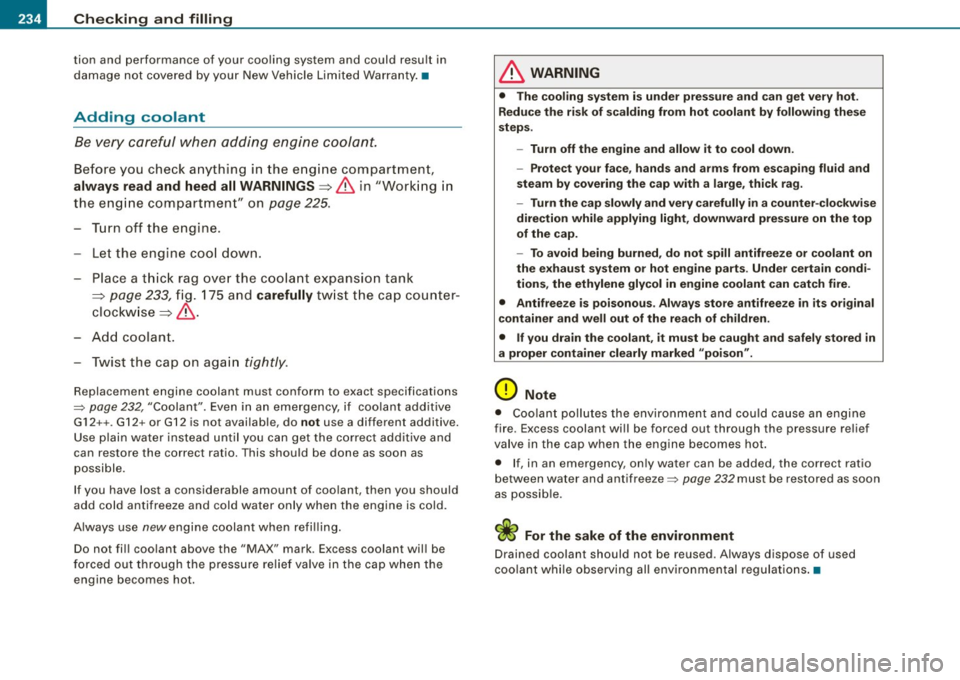
-~_C_ h_e _c _ k_ i_n ...:::g::;...._ a_n_ d_ f_ i_ll _in -'g:::;.._ ___________________________________________ _
tion and performance of your cooling system and could resu lt in
d am age not co vered by yo ur Ne w Vehicle Li mited Warranty .•
Adding coolant
B e very caref ul whe n addin g engine c oo lant.
Before you check a nything in the e ngine compartmen t,
always read and heed all WARNINGS=> & in "Work ing in
the en gine compartmen t" on
pa ge 225.
- Turn off the engine.
- Le t the engin e coo l down.
Place a thi ck ra g o ver th e c oolan t expansio n ta nk
=> pa ge 233, fi g. 1 75 a nd carefully twi st th e cap coun te r
cl ockwi se
=> &.
- Add cool ant.
- Twist the cap on aga in
tightly.
Replacement engine coolant must conform to exact specifications
~ page 232, "Coola nt". Even in a n eme rge ncy, if co olant add itive
G 12++. G12+ or G 12 is not availab le, do
not use a diffe rent additive.
Use plain water instead unt il you ca n get the c orrect additive and
can restore the correct ratio . This should be done as soon as
possible.
If you have lost a considerable amount of coo lant, then you should
add co ld antifreeze and cold water only when the engine is cold.
A lways use
new e n gin e c oolan t wh en refi llin g.
Do not fi ll coo lant above the "MAX" mark. Excess coolant will be
f o rced ou t through the pressure re lief va lve in the cap when the
engine becomes hot.
& WARNING
• The cooling system is under pressure and can get very hot .
Redu ce the risk of scalding from hot coolant by following these
steps .
- Turn off the engine and allow it to cool down.
- Protect your face , hands and arms from e scaping fluid and
steam by covering the cap with a large, thick rag.
- Turn the cap slowly and very carefully in a counter -clockwise
direction while applying light , downward pressure on the top
of the cap.
- To avoid being burned , do not spill antifreeze or coolant on
the e xhaust system o r hot engine parts . Under certain condi
tions , the ethylene glycol in engine coolant can catch fire.
• Antifreeze is poisonous . Always store antifreeze in its original
container and well out of the rea ch of children.
• If you drain the coolant , it must be caught and safely stored in
a proper container clearly marked "poison".
0 Note
• Coo la n t po llutes t he environ ment and cou ld cause a n engine
fire . Excess coolant will be forced out through the pressure re lief
va lve in t he cap when t he eng in e b ecomes hot .
• I f, in an emergency, on ly water can be added, the correct ratio
be tween wa ter and antifree ze~
page 232 mus t be restore d as soon
as possib le .
'£> For the sake of the environment
D rained coolant should not be reused. Always d ispose of used
coo la nt whi le observing all e nvi ro n men tal reg ulat ions .•
Page 237 of 324
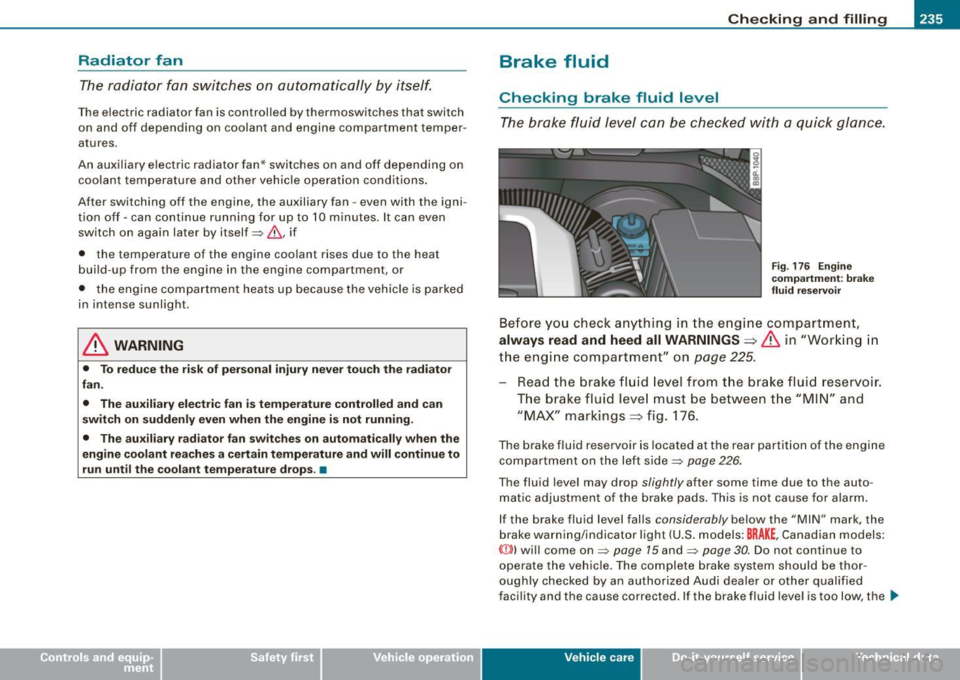
Checking and filling -
---------------------=----"=---------
Radiator fan
The radiator fa n switches on au toma tically by i tself.
T he e lectric radiator fan is control led bythermoswitches that switch
on and off depending on coolan t and engine compar tm ent temper
atures .
An auxiliary e lectric radiator fan * switches on and off depending on
coolant temperature and other vehicle operation conditions.
After switching off the engine , the auxiliary fan -even with the igni
tio n off -ca n co ntinue runni ng for u p to 10 minutes. It can even
switch on again later by itself=>&, if
• the temperat ure of the engine coolant rises due to the heat
build -up from the engine in the engine compartment, or
• t he engine co mpart men t heats up because the vehicle is parked
in intense sunlight.
& WARNING
• To reduce the risk of personal injury never tou ch the r ad iator
fan .
• The auxiliary electric fan is temperature controlled and can
switch on suddenly even when the engine i s not running .
• The auxiliary radiator fan switches on automatically when the
engine cool ant reache s a certain temperature and will continue to
run until the coolant temperature drop s. •
Brake fluid
Checking brake fluid level
The bra ke flu id l evel can be che cke d wi th a q uick gla nce.
Fig . 17 6 Engine
c o mpartment : brake
fluid re ser vo ir
Be fore yo u check anythin g in the e ng ine compar tm ent,
always read and heed all WARNINGS=> & in "Working in
t h e eng ine compartment" on
page 225.
Read t he brake fl uid lev el from t he brake flui d res ervoir .
T he b rak e fluid l eve l must b e between the
"MI N" and
"M AX" markings => fig. 176.
The brake f luid reservoir is located at the rear pa rtit ion of the engine
compartment on the left side=> page 226.
T he fluid leve l may drop slightly after some time due to the auto
ma tic adjustment o f the brake pads. Th is is not cause for alarm .
I f the brake flu id leve l falls considerably below the "MIN" mark, the
brake warning/indicator light (U.S . models :
BRAKE, Canadian models:
ID ) will come on=> page 15 and=> page 30. Do not continue to
operate the vehic le . The complete brake system should be thor
oughly checked by an au thorized Audi dealer or other qualified
facility and the cause corrected. If the brake fluid leve l is too low, the .,,_
Vehicle care I I irechnical data
Page 239 of 324
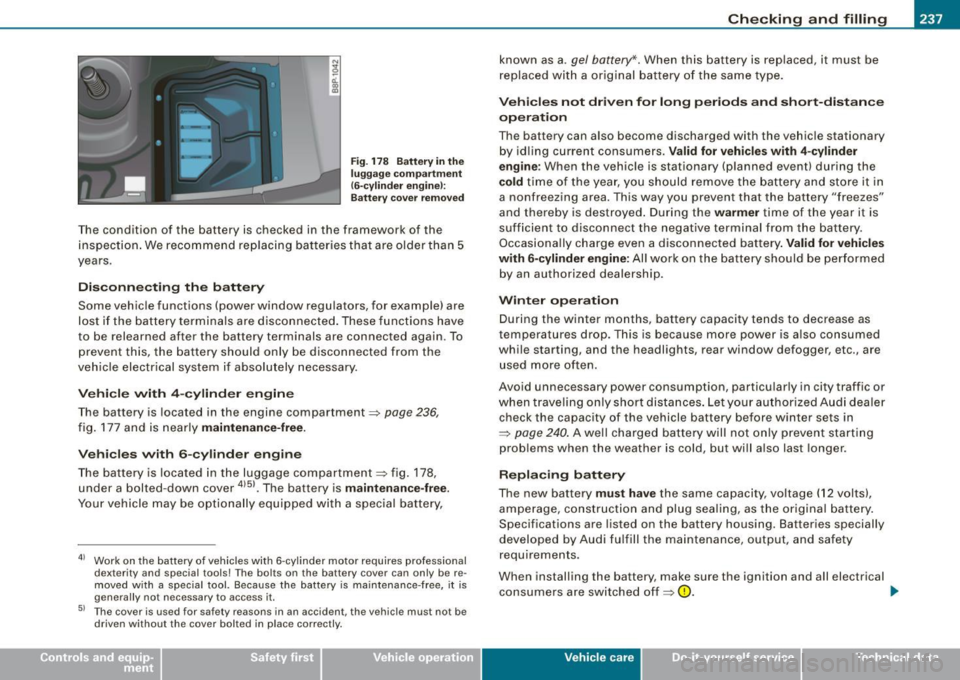
_____________________________________________ C_h_ e_ c _ k_in -= g_a _ n_d _ f_il _li _n ..;::g =--____.•
N
~ a:. 00 m
F ig . 178 Battery in the
lugg ag e co mpartme nt
(6-c ylind er eng ine !:
Ba tter y cove r remo ved
T he condition of the battery is checked in the framework of the
inspection . We recommend rep lacing bat teries that are older than 5
years .
Disconnecting the battery
Some vehic le functions (power window regu lators, for example) are
lost if the battery terminals are disconnected . These functions have
to be relearned after the battery terminals are connected again. To
prevent this, the battery should only be disconnected from the
veh icle electr ical system if absolutely necessary.
V ehicle with 4 -cylind er engin e
The battery is located in the engine compartment~ page 236,
fig. 177 and is nearly maintenance -free.
Vehi cle s with 6 -cylinder engine
The bat tery is loca ted in the luggage compartmen t=:> fig . 178,
under a bolted-down cover
4151 • The battery is maintenan ce -free .
Your ve hicle may be optionally equipped with a special battery,
41 Wor k on the battery of vehicles with 6-cy linder motor requires professional
dexterity and special tools! The bolts on the battery cover can only be re
m oved w ith a s pecial tool. Because the batte ry is ma in tenance -free, it is
genera lly not necessary to access it.
51 The cover is used for safety reasons in an acc ident, the vehicle must not be
driven without the cover bolted in place correctly.
known as a. gel battery* . When this battery is replaced, it must be
replaced wi th a or iginal bat tery o f th e same type.
Vehicles not dri ven for long periods and short-distance
operation
The battery can a lso become discharged with the vehicle stationary
by id ling current consumers .
Valid for vehicles with 4 -cylinder
engine :
When the vehic le is stationary (planned event) during the
cold time of the year, you sh ould remove the battery an d store it in
a nonfreezing area. This way you prevent that the battery "freezes"
and thereby is destroyed . During the
warmer time of the year it is
suff icient to disconnect the negative terminal from the battery .
Occasiona lly charge even a disconnected battery .
Valid for veh icles
with 6 -cylinder engine:
All wor k on the ba ttery should be per formed
by an authorized dealership.
Winter op eration
During the winter months, battery capacity tends to decrease as
temperatures drop. This is because more power is a lso consumed
while starting, and the headlights, rear window defogger, etc., are
use d more often .
Avoid unnecessary power consumption, particularly in city traffic or
wh en trave ling on ly shor t distances . Let you r au thor ize d Audi dea ler
check the capacity of the vehicle battery before winter sets in
~ page 240 . A well charged battery will not on ly prevent sta rting
problems when the weather is cold, but wi ll a lso last longer .
Replacing battery
The new battery must have the same capacity , vo ltage (12 volts),
a m perage, con struction and plug sea ling, as t he origina l battery.
Specifications are listed on the battery housing. Batteries specially
developed by Audi fulfill the maintenance, output, and safety
requirements.
When installing the battery , make sure the ignition and all electrical
co nsumers are switche d off ~
0. ..,
Vehicle care I I irechnical data
Page 240 of 324

-~_C_ h_e _c _ k_ i_n ...:::g::;...._ a_n_ d_ f_ i_ll _in -'g:::;.._ ___________________________________________ _
We recommend that you use maintenance-free or cycle-resis
tant/leak-proof batteries according to the standards TL 825 06 (from
December 1997) and VW 7 50 73 (from August 2001 ).
Replacing the battery on vehicles with the 6-cylinder engine (battery
in the luggage compartment) should be carried by a qualified work
shop. On vehicles with the 6 -cylinder engine, please follow the
instructions on the battery cover.
0 Note
• All work on the battery requires technical knowledge. Please
contact an Audi dealership or another authorized facility for ques
tions about the battery -danger of acid burns and explosion hazard!
• Th e battery must not be opened! Do not try to change the
battery's liquid level, otherwise detonating gas will escape from the
battery -explosion hazard!
• The AGM battery in the luggage compartment cannot leak,
because the electrolyte for this battery is absorbed into a special
glass mat. This leak-proof battery must not be replace with a
conventional battery .
• Make sure the ventilation hose on the side of the battery is
connected, otherwise fumes or battery acid can leak out.
• Battery holder and terminals always have to be secured correctly.
• Before all work on the battery follow the warnings below::::,
& in
"Wor king on the battery" on page
238.
W For the sake of the environment
Because of the problem of proper disposal of a battery, we recom
mend your authorized Audi dealer change the battery for you.
Batteries contain sulfuric acid and lead and must always be
disposed of properly in compliance with all environmental regula
tions . Disposing of vehicle batteries improperly is very dangerous to
the environment. Make sure that the removed battery cannot over
balance, otherwise sulfuric acid might escape! •
Working on the battery
All work on the battery requires technical knowledge! Be
especially careful when working on or near the battery!
Before you check anything in the engine compartment,
always
read and heed all WARNINGS :::;, & in "Working in
the engine compartment" on
page 225.
Always heed the safety warnings, when working on the vehicle
battery or the vehicle electrical system to prevent injury.
The following WARNINGS are very important when
working on the battery:
Always heed the following WARNING SYMBOLS and safety pre cautions when working on the battery.
@
Always wear eye protection.
Battery acid contains sulfuric acid. Always wear
gloves and eye protection.
No
- sparks
- flames
- smoking.
When a battery is charged, it produces hydrogen
gas which is explosive and could cause personal
injury.
Always keep the battery well out of reach of chil
dren .
& WARNING
Whenever working on the battery or on the electrical system,
there is the risk of injury, accident and even fire. Read and heed the
following WARNINGS:
~
Page 241 of 324
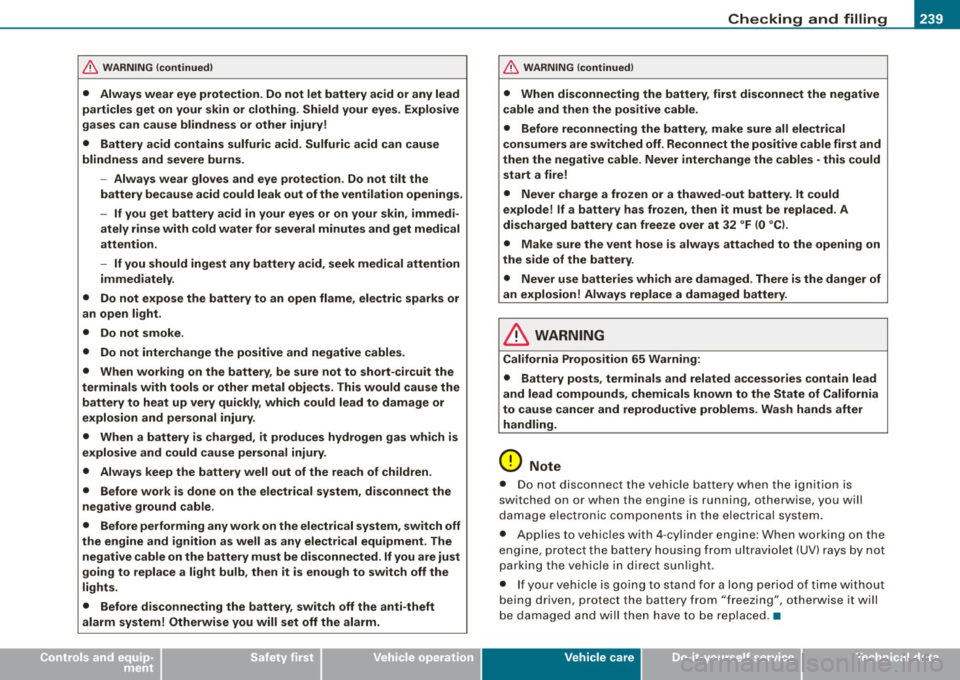
___________________________________________ C_ h_e _c_ k_ i_n _g _ a_n _d_ f_il _li _n _g __ lR
•
& W ARNING (continu ed )
• Always wear eye protection. Do not let battery acid or any lead
particles get on your skin or clothing . Shield your eyes. Explosive
gases can cause blindness or other injury !
• Battery acid contains sulfuric acid . Sulfuric ac id can cause
blindness and severe burns .
- Always wear gloves and eye protection. Do not tilt the
battery because acid could leak out of the ventilation openings.
- If you get battery acid in your eyes or on your skin , immedi
ately rinse with cold water for several minutes and get medical
attention .
- If you should ingest any battery acid , seek medical attention
immediately .
• Do not expose the battery to an open flame , electric sparks or
an open l ight .
• Do not smoke.
• Do not interchange the positive and negative cables .
• When working on the batte ry , be sure not to short -circuit the
terminals with tools or other metal objects . This would cause the
battery to heat up very quickly , whi ch could lead to damage or
explosion and personal injury .
• When a battery is charged , it produces hydrogen gas which is
explosive and could cause personal injury .
• Always keep the battery well out of the reach of children .
• Before work is done on the electrical system, disconnect the
negat ive ground cable .
• Before performing any work on the electrical system , switch off
the engine and ignition as well as any electrical equipment . The
negative cable on the battery must be disconnected . If you are just
going to replace a light bulb , then it is enough to switch off the
lights.
• Before disconnecting the battery , sw itch off the anti-theft
alarm sy stem! Otherwise you will set off the alarm.
& W ARNING (continued )
• When disconnecting the battery, first disconnect the negative
cable and then the positive cable.
• Before reconnecting the battery , make sure all electrical
consumers are switched off. Reconnect the positive cable first and
then the negative cable . Never interchange the cables -this could
start a fire!
• Never charge a frozen or a thawed -out battery. It could
explode!
If a battery has frozen , then it must be replaced . A
discharged battery can freeze over at 32 °F (0 °CI.
• Make sure the vent hose is always atta ched to the opening on
the side of the battery.
• Never use batteries which are damaged . There is the danger of
an explosion! Always replace a damaged battery .
& WARNING
California Proposition 65 Warning:
• Battery posts , terminals and related accessories contain lead
and lead compounds , chemicals known to the State of Californi a
to cause cancer and reproductive problems . Wash hands after
handling.
0 Note
• D o not d iscon nect the veh ic le bat tery w hen the ign it io n i s
switched on or when the engine is ru nning, otherwise, you wi ll
da mag e ele ctro nic c ompo nents in the e lectr ical system.
• Appl ies to vehic les with 4 -cylinde r engine: When working on the
eng ine, protec t th e batter y hous ing from ultrav iolet ( UV) rays by not
parking the vehicle in direct sun light .
• If y our veh icl e is goi ng to sta nd for a lo ng period o f time with out
being dr iven, protect the battery from "freezing", otherwise it will
b e dama ged and w ill t hen ha ve to be replaced .•
Vehicle care
I t •
Page 242 of 324

-~_C_ h_e _c _ k_ i_n ...:::g::;...._ a_n_ d_ f_ i_ll _in -'g:::;.._ ___________________________________________ _
Applies to vehicles: w ith 4-cy linder engine
Charging of battery (4 -cylinder engine)
All work on the battery requires technical knowledge!
A charged battery ensures good star ting performance. A
discha rged battery can
freeze at temperatures of only O °C.
A thawed battery must be replaced, as the battery housing may be cracked due to freez ing and could therefore leak
acid .
-Always read and heed all WARNINGS below=> & and
=> & in "Working on the battery" on
page 238.
-Sw itch off the ignit ion and all e lectr ica l co nsumers .
- Make s ure the a rea is we ll ven tilated when y ou c harge
the batte ry.
- Connec t cha rger cab les.
Charger cable s mu st alway s be
conne cted POSITIVE
G) to POSITIVE G) and NEGATIVE Q
to NEGATIVE Q.
- Switch on the charger.
- Make sure the charging rate is not over 6 amps.
- Turn off th e ch arge r=> & .
- Disconnect the c harger cables.
- Connect both battery cables to the battery if necessary -
first plus, then minus .
The battery must not be opened!=> 0 in "General information" on
page 236.
It is not necessary to remove the battery from the engine compart
ment, and it is also not necessary to disconnect the cables .
Normally, a battery shou ld be charged at no more than 10 percent
of its rated capacity. For example, a charging
current of 4.5 amps would be used on a
b attery rated at 45 Ah. Rated capacity of the battery in your vehic le
is listed on the battery housing.
The battery caps should
not be opened when charging a battery .
& WARNING
Charging a battery c an be dangerou s.
• Never ch ar ge a fro zen batt ery. It m ay ex pl ode be cause of g as
trapped in the i ce. Allow a fro zen battery to thaw out fir st.
• Do not reu se b atteries whic h w ere fro zen . The batter y housing
ma y hav e cra cked and weakened when the batter y fro ze.
• Charge the b atter y in a w ell vent ila ted area . K eep away from
open flame or e le ctric al s p a rk . Do not smoke . Hydrogen g as gener
a ted by t he b attery i s ex plo sive .
• To redu ce the dang er of e xplo sion , never connect o r di sconnect
c h arger cables while t he ch arger is operating .
• Fas t ch ar ging a batte ry is dang erou s and should only be
att empted by a comp etent techni cian with the proper equipment .
• Batter y ac id that m ay spill durin g ch arging should be wa shed
off with a solution of warm water and baking soda to neutr alize
the acid.
0 Note
Never use a fast charger as a booster to start the engine. This will
seriously damage sensitive electronic components, such as control
units, re lays, radio, etc ., as well as the battery charger.
[ i ] T ips
The veh icle battery must not be charged with a standard sma ll
charger that plugs into the cigarette lighter or out let. •
Page 243 of 324

_____________________________________________ C_h_ e_ c _ k_in -= g_a _ n_d _ f_il _li _n ..;::g =-- ____.•
Ap plies t o vehicles: w ith 6 -cylin d er engine
Charging of battery 6 -cylinder engine )
All work on the battery requires specialized knowledge!
The battery is maintenance-free and is inspected regu
larly as part of vehicle service.
If starting problems occur because the battery charge is too low,
this may indicate a defective battery. In this case we recommend
having a qualified workshop inspect and charge the battery or
replace it if necessary. A discharged battery can
freeze at tempera
tures of only O °C. A thawed battery must be replaced, as the battery
housing may be cracked due to freezing and could therefore leak
acid.
Charging the battery
Battery charging should be performed by a qualified workshop,
since batteries employing a special technology are used which
require current-limited constant voltage charging.
0 Note
The vehicle may be optionally equipped with a gel battery, which can only be charged at a constant current-limited voltage.
• To prevent damage to the battery and the electronics system, a
gel battery that is connected must under no circumstances be
charged with a quick charger.
[ i] Tips
The vehicle battery must not be charged with a standard small
charger that plugs into the cigarette lighter or outlet. •
Windshield washer container
Using plain water is not adequate for filling the wind
shield washer system.
Fig . 179 Engine
compartment : wind
shield washer fluid
container
The windshield washer fluid container is located on the
right side of the engine compartment~ fig. 179. The
washer fluid container is marked with the symbol %Pis on
its cap.
- Before you check anything in the engine compartment,
always
read and heed all WARNINGS~ & in "Working
in the engine compartment" on
page 225.
-Lift the filler cap tongue to add washer fluid. You can fill
the container to the top.
- Press the cap back onto the filler neck after filling the
container.
You can find the reservoir capacity in the table in~ page 300.
To prevent lime residue from building up on the spray jets, use
distilled water when refilling. Always add a glass cleaner solution
(with frost protection in the winter}. .,._
Vehicle care I I irechnical data
Page 244 of 324
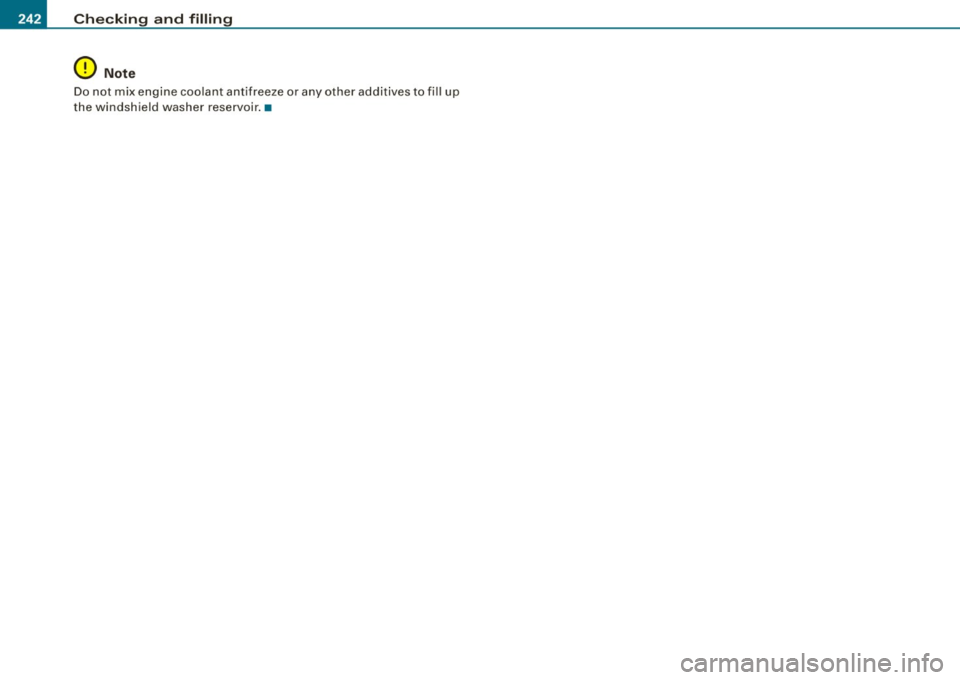
-~_C_ h_e _c _ k_ i_n ...:::g::;...._ a_n_ d_ f_ i_ll _in -'g:::;.._ ___________________________________________ _
0 Note
Do not mix engine coolant antifreeze or any other additives to fill up
the windshield washer reservoir .•
Page 250 of 324
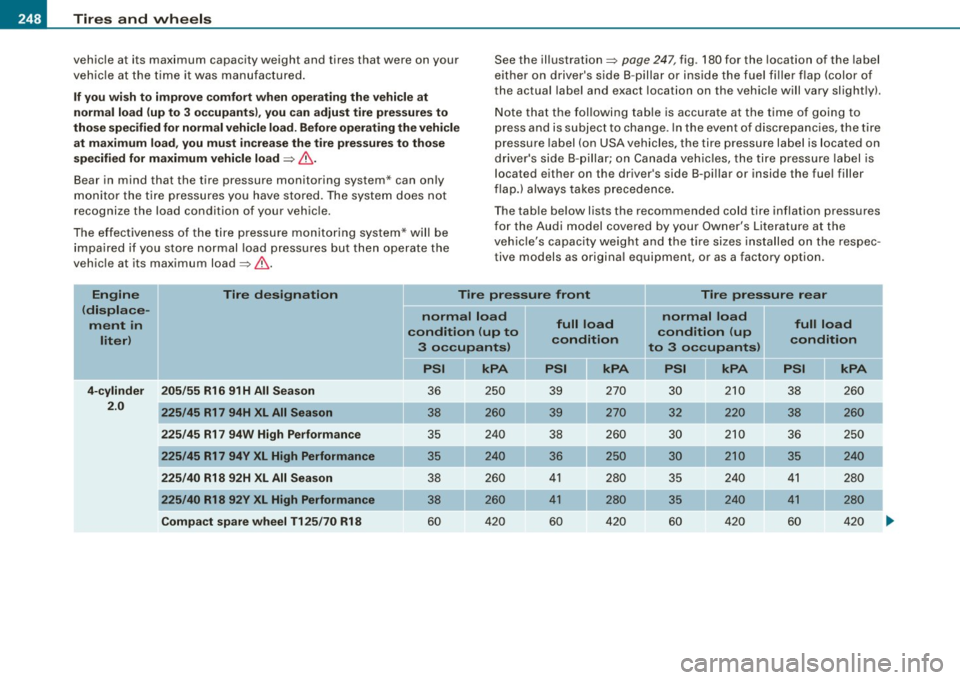
-~_T_ ir_e_ s_ a_ n_d _ w_ h_ e_e _l_s _________________________________________________ _
vehicle at its maximum capacity weight and tires that were on your
vehicle at the time it was manufactured.
If you wish to improve comfort when operating the vehicle at
normal load (up to 3 occupants), you can adjust tire pressures to
those specified for normal vehicle load. Before operating the vehicle at maximum load, you must increase the tire pressures to those
specified for maximum vehicle load
=> &.
Bear in mind that the tire pressure monitoring system* can only
monitor the tire pressures you have stored. The system does not
recognize the load condition of your vehicle.
The effectiveness of the tire pressure monitoring system* will be impaired if you store normal load pressures but then operate the
vehicle at its maximum load=>&. See
the illustrat ion=>
page 247, fig. 180 for the location of the label
either on driver's side B -pillar or inside the fuel filler flap (color of
the actual label and exact location on the vehicle will vary slightly).
Note that the following table is accurate at the time of going to
press and is subject to change . In the event of discrepancies, the tire
pressure label (on USA vehicles, the tire pressure label is loc ated on
driver's side B-pillar; on Canada vehicles, the tire pressure label is
loca ted either on the driver's side B-pillar or inside the fue l filler
flap.I always takes precedence.
The table below lists the recommended cold tire inflation pressures
for the Audi model covered by your Owner's Literature at the
vehicle's capacity weight and the tire sizes installed on the respec
tive models as original equipment, or as a factory option.
Engine
(displace
ment in
liter)
Tire designation Tire pressure front
Tire pressure rear
4-cylinder
2.0
205/55 R16 91 H All Season
225/45 R17 94H XL All Season
225/45 R17 94W High Performance
225/45 R17 94Y XL High Performance
225/40 R18 92H XL All Season
225/40 R18 92Y XL High Performance
Compact spare wheel T125/70 R18 normal load
condition (up to
3 occupants)
PSI
36 250
38 260
35 240
35 240
38 260
38 260
60 420
full load
condition
kPA
39 270
39 270
38 260
36 250
41 280
41 280
60 420
normal load
full load
condition (up
condition to 3 occupants)
kPA kPA
30 210
38 260
32 220 38 260
30 210
36 250
30 210
35 240
35 240 41 280
35 240 41 280
60 420
60 420
Page 270 of 324

___ T _i_r e_=- p_r_e _ s_ s_ u_r_ e _ m_ o_ n_i_t _o _r_ i _ n .,;:g ::;.._ s_ y=--- s_t _e _m_ * __________________________________________ _
• A wheel sensor or other component may have failed.
• During ini tializat ion the system has detected more tha n 4 wheels
on the vehicle, for example whi le driving next to another car with a
tire pressure monitoring system.
• A wheel change was made but the button
:=:, page 266, fig. 186
was not pressed.
• Audi Genuine Parts were not used for parts replacement .
• If snow chains are being used, system function can be compro
mised due to the shielding properties of the chains.
• The tire pressure monitoring system may not be avai lable
because of a radio malfunction.
• Transmitters with the same frequency, such as radio head
phones in the vehic le or radio equipment, can cause a temporary
disruption of the system through excessive electromagnetic fields .
• Eliminate the interference if possible and then proceed as
follows: Turn off the engine for 20 minutes. Then drive another 10
min. If the warning light comes on again, you shou ld con tact your
authorized Audi dealer immediately to have the prob lem corrected.
• Do not use commercially avai lab le tire sea lants . Otherwise, the
e lectrica l components of the tire pressure monitoring system wi ll
no longer work properly and the sensor for the tire p ressure moni
toring system wil l have to be rep laced by an authorized Audi dealer
or o ther qua lified workshop .•
Certification
This device complies with part 15 of the FCC rules and RSS -210.
Operation is subject to the following conditions:
• this device may not cause harmful interference, and
• this device must accept interference rece ived, including interfer
ence that may cause undesired operation.
The receiver 5WK49069 uses the same schematic, assemb ly, layout
and PCB as 5WK49097 . 5WK49097 is a multi channel receiver and 5WK49069 is a single channe
l receiver . They only differ in : SAW
Filter V1 _4 was changed from A2C00038979 to V1 _2 A2C00032378,
Inductor L5_3 and L6_233nH were changed to L5 _2 and L6 _247nH .
BAND PASS FILTER V3_2 was changed from A2C00038762 to V3_3
A2C00036085. V10 : ATIC75 C1, A2C000029505 was changed to V10 :
ATIC75 C2-Light, A2C000043220 . Q1 14.246MHz A2C00037710 was
changed to Q1 15.27MHz A2C00041280 . The BAND PASS FI LTER V2
is not populated .
These modifica tions were necessary to optimize the characteris tic
of the receiver.
Proof is shown with test report T30739 -00 -00KJ issued by Mikes
Testingpartners GmbH, Ohmstral5e 2-4 , 94342 Strasski rchen that
the receiver is be low the limit .•